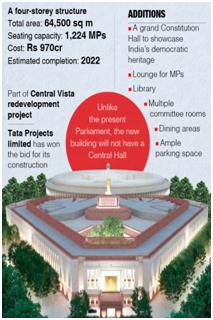

Prime Minister Narendra Modi laid the foundation stone of the new Parliament building in New Delhi.
Context
Prime Minister Narendra Modi laid the foundation stone of the new Parliament building in New Delhi.
About
- Location: To be built over 64,500 sq m, it will be located a stone's throw from Rashtrapati Bhavan, the official residence of the President of India.
- Design and structure: The four-storey buildingwill be triangular and its interiors will have three national symbols - the lotus, the peacock and the banyan tree - as its themes.
- Estimated cost: The parliament building alone will cost an estimated ? 971 crore.
- Duration: The building is expected to be ready before India's 75th Independence Day (in 2022). However, construction cannot yet begin as a legal challenge is pending in the Supreme Court.
- The new parliament building will be the highlight of the ambitious ? 20,000 crore Central Vista project that PM Modi said will become "a symbol of a new and self-reliant India".
|
Central Vista
|
Important features of the building
- The national emblem will crown the new parliament, the ceiling of which will have fresco paintings (similar to those in Rashtrapati Bhawan) and carpets with traditional designs.
- Interior walls will have shlokas inscribed - to retain some of the characteristics of the existing parliament.
- Dholpur stone will be the primary construction material (as it was with the current building) and red granite may replace red sandstone in some interior sections. Special care will be taken during construction to ensure minimal disturbance and environmental safeguards.
- Seating capacity: The new Parliament House will have a seating arrangement of 888 members in the Lok Sabha. At present, India has 543 Lok Sabha seats.
- Similarly, 384 members will be able to sit in the Rajya Sabha of the new Parliament House, which currently has 245 seats.
- When a joint meeting of the two houses is convened at the new Parliament House, the hall earmarked for it will have a seating arrangement of 1,272 members. At present, the joint meeting of the two Houses is held at the Centre Hall with only 430 seats.
- The new Lok Sabha and Rajya Sabha halls will have increased seating capacities (888 and 384 seats, respectively) in anticipation of an expanded Parliament; a 25-year-old freeze on increasing state-wise distribution of seats ends in 2026.
- Atmanirbhar Parliament: The new Parliament building will be an intrinsic part of the vision of 'Atmanirbhar Bharat' as artisans and sculptors from all over the country would contribute to and showcase India's cultural diversity in the new building.
- Earthquake safety: The new Parliament building will also be able to withstand earthquakes.
The current Parliament building
- The present Parliament House was inaugurated on January 18, 1927. Its architectural work was entrusted to Sir Herbert Baker.
- The giant circular building with its 144 sandstone columns was designed by Sir Edward Lutyens, who also designed the heart of Delhi – from the seat of the government in the North Block to the iconic Connaught Place.
- Sir Herbert Baker wanted the Parliament House to be triangle-shaped. A central hall should be built in between.
- But then British architect Sir Edwin Lutyens opposed it. He had suggested shaping it round in his proposal. Ignoring Herbert Baker's suggestion, the British had accepted Edwin Lutyens' proposal.
- The existing Parliament building will be conserved as an archaeological asset of the nation.



